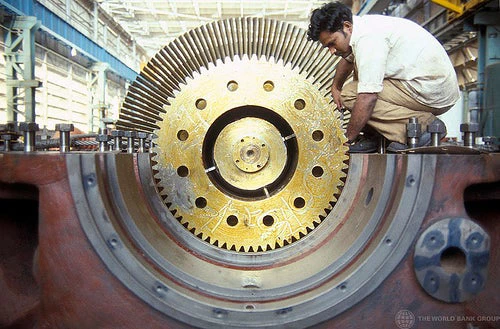Successful industrial parks can drive economic competitiveness (Credit: World Bank, Flickr)
Why do so many industrial park programs fail? They are popular across the developing world, inspired perhaps by China, where they are widely used as a policy tool and where their products are impressive to the visitor: functional parks with many firms and bustling activity. But horror stories abound, even in China, of empty parks, subsidized land speculation and tax erosion, and often no parks at all. This has not dampened enthusiasm, however. The theory is simply too seductive. By providing high-quality, shared infrastructure to firms in specific areas, industrial parks are meant to create pockets of competitiveness that eventually spill over onto the rest of the economy. For capacity-constrained governments, they have the further appeal of focus.
Some still question the cost-benefit calculation of even the successes, such as China. In India, where parks are no less popular than elsewhere, the first question is not even about outcomes, but just about outputs. Most park programs here have suffered multiple controversies, including the much-heralded “Special Economic Zones” (SEZ) program. So our curiosity was naturally piqued by a recent initiative in India that appeared to buck the trend: Parks seemed to get built and attract investment and jobs. Out of 40 such parks approved between the end of 2005 and 2010, 60 percent (24 parks) had already started commercial production by the end of 2012, while only 10 percent had been canceled.
Five years to get a park running may seem long, but is well above expectations for previous park programs here. According to the data we have seen, private investments in the parks already represent four times as much as public grants, and more than 40,000 jobs have been created. Today demand for more parks is sky-high. So we wondered: How was this achieved? Clearly, it was not a change in the investment climate, or publicity, or “political will.” The SEZ scheme was launched almost concurrently, with more publicity and more incentives, but with much more disappointing results. Easy “input” or “environment” explanations would not do the trick. So we conducted a thick case study, one recently released by the Competitive Industries Global Practice. In it we focused on performance, instead of inputs, with a simple three-step approach:
• Second, examine the incentives and capacity for each actor to perform its role, given the local context;
• Third, analyze how that match of incentives and roles affected the chance of four kinds of failure: getting parks built, attracting investments into them, spurring competitiveness, and pulling up the rest of the economy.
In this light, we found the principal innovation in the Scheme for Integrated Textile Parks (SITP) was the way it gave an early, decisive role to one oft-forgotten stakeholder: the users of the parks. It’s not the government, plus a consultant, that picks where and how big the park will be, then tries to get the parks built and filled (with or without the help of private developers). Instead, prospective firms do it themselves, while the government focuses on providing co-funding and on monitoring.
Why does this improve outputs so much? Because it means that park location and dimension decisions now become costly to those who make them. Just as important, with India’s scale and diversity, it puts the burden of navigating local informal relationships – with local authorities, land sellers and so on – on those best placed to do it.
Besides this, we also uncovered other important features: the role of “Project Management Consultancies” (PMCs) to alleviate capacity constraints for both the government and firms; a staged grant allocation mechanism that disciplines firms and PMCs; keeping parks right-sized, neither too small nor too large, thus creating just enough scale without attracting too much political attention; and making support conditional on firms cooperating on a number of immediate issues, thus reinforcing cohesion and effort. Significantly, the study does not begin to claim that the scheme is a panacea: It remains early days. In particular, we had a sense through extensive field visits that the scheme seemed to be generating forms of common activities in the parks, but could experiment with doing more. The study also warns against the temptation for superficial replication. There are particularities to India’s political economy, as well as to the structure of its textile industry, that may make it welcoming terrain for such a scheme, in a way that other industries in other countries will not be. Simplistic replication will be highly dangerous.
There is wide scope for learning, though, and a range of environments in which, we believe, some features of this scheme may prove useful. The most important lesson might be this: Thinking in new and creative ways about who does what, and how, within a given political economy, can lead to policy innovations and relative successes in areas previously characterized by a long record of poor performance.




Join the Conversation